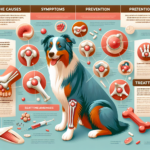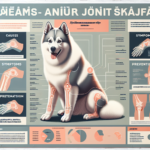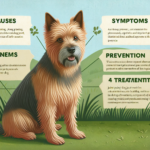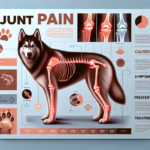Australian Shepherd Joint Pain: Causes, Symptoms, Prevention, and Treatment

Introduction
The Australian Shepherd, often affectionately called the “Aussie,” is a highly intelligent and energetic breed known for its versatility and work ethic. Originating in the United States, despite its name, the breed was developed to herd livestock and is renowned for its agility, endurance, and keen sense of duty. Aussies are medium-sized dogs with a strong, muscular build, and they typically have a life expectancy of 12-15 years. Their striking appearance, characterized by a variety of coat colors and patterns, along with their expressive eyes, makes them a favorite among dog enthusiasts.
While Australian Shepherds are generally healthy dogs, they are prone to certain health issues, including eye problems, epilepsy, and joint-related conditions. Joint pain is a significant concern for this breed, given their active lifestyle and genetic predispositions. Ensuring joint health is crucial for maintaining the overall well-being and quality of life of an Australian Shepherd.
Breed-Specific Joint Pain Risks
Genetic Predisposition
Australian Shepherds are genetically predisposed to several joint-related issues, including hip dysplasia, elbow dysplasia, and arthritis. Hip dysplasia is a condition where the hip joint does not fit into the hip socket properly, leading to pain and mobility issues. Elbow dysplasia involves abnormal development of the elbow joint, causing lameness and discomfort. Arthritis, a degenerative joint disease, can also affect Aussies, leading to chronic pain and stiffness.
Age-Related Risks
As Australian Shepherds age, the risk of developing joint pain increases. While young Aussies may show signs of joint issues due to genetic factors, older dogs are more susceptible to arthritis and other degenerative joint conditions. Owners should be vigilant about joint health as their dog approaches middle age, typically around 5-7 years, and continue monitoring into their senior years.
Activity Level and Joint Stress
Australian Shepherds are known for their high energy levels and need for regular physical activity. Whether they are working on a farm, participating in agility competitions, or simply enjoying an active lifestyle with their owners, the constant movement can put significant stress on their joints. While exercise is essential for their overall health, excessive or improper activity can exacerbate joint issues.
Common Symptoms of Joint Pain in Australian Shepherds
General Symptoms
- Limping: One of the most noticeable signs of joint pain is limping or favoring one leg over another.
- Stiffness: Dogs may show stiffness, especially after resting or sleeping, which can indicate joint discomfort.
- Reluctance to Move: A dog in pain may be hesitant to engage in activities they once enjoyed, such as running, jumping, or climbing stairs.
- Swelling: Visible swelling around the joints can be a sign of inflammation and pain.
- Behavioral Changes: Irritability, lethargy, or changes in appetite can also be indicators of joint pain.
Breed-Specific Symptoms
In Australian Shepherds, joint pain may manifest in specific ways due to their active nature. Owners might notice a decrease in their dog’s enthusiasm for physical activities or a reluctance to perform tasks that require agility and strength. Additionally, Aussies may exhibit a more pronounced limp or stiffness after intense exercise sessions.
When to Consult a Vet
If an Australian Shepherd shows any signs of joint pain, it is essential to consult a veterinarian promptly. Early diagnosis and intervention can prevent further deterioration and improve the dog’s quality of life. Persistent limping, noticeable swelling, or significant changes in behavior should all prompt a veterinary visit.
Preventive Measures for Joint Health
Exercise Recommendations
Regular exercise is crucial for maintaining joint health in Australian Shepherds, but it should be balanced and appropriate for their age and condition. Low-impact activities such as swimming and controlled walking can help keep joints flexible without causing excessive stress. Avoid high-impact exercises like jumping or running on hard surfaces, especially for puppies and older dogs.
Dietary Suggestions
A balanced diet rich in essential nutrients can support joint health. Foods containing glucosamine, chondroitin, and omega-3 fatty acids are particularly beneficial. These nutrients help maintain cartilage health and reduce inflammation. Owners can also consider joint supplements specifically formulated for dogs, but it is advisable to consult a veterinarian before adding any supplements to the diet.
Weight Management
Maintaining a healthy weight is vital for reducing joint stress in Australian Shepherds. Excess weight can exacerbate joint pain and lead to further complications. Owners should monitor their dog’s weight and adjust their diet and exercise routine accordingly. Regular veterinary check-ups can help ensure the dog remains within a healthy weight range.
Early Screening and Monitoring
Early screening for joint issues can help catch problems before they become severe. Regular veterinary check-ups should include joint assessments, especially for dogs with a family history of joint problems. X-rays and other diagnostic tools can help identify issues early, allowing for timely intervention and management.
Treatment Options for Joint Pain
Non-Surgical Treatments
Non-surgical treatments for joint pain in Australian Shepherds include medications, physical therapy, and lifestyle adjustments. Anti-inflammatory drugs and pain relievers can help manage symptoms, while physical therapy can improve mobility and strengthen muscles around the joints. Lifestyle adjustments, such as providing a comfortable resting area and avoiding strenuous activities, can also alleviate pain.
Surgical Options
In severe cases, surgical intervention may be necessary. Common surgeries for joint issues include hip replacement, arthroscopy, and joint fusion. These procedures can significantly improve the dog’s quality of life, but they come with risks and require a thorough discussion with a veterinarian. Post-surgical care and rehabilitation are crucial for successful recovery.
Alternative Therapies
Alternative treatments like acupuncture, hydrotherapy, and massage can also benefit Australian Shepherds with joint pain. Acupuncture can help reduce pain and inflammation, while hydrotherapy provides low-impact exercise that strengthens muscles without stressing the joints. Massage therapy can improve circulation and alleviate muscle tension around the affected joints.
Lifestyle and Management Tips
Daily Care Routine
A daily care routine for an Australian Shepherd with joint pain should include gentle exercise, a balanced diet, and regular monitoring of symptoms. Short, frequent walks and low-impact activities like swimming can keep the dog active without causing additional pain. Providing a comfortable resting area with orthopedic bedding can also help alleviate discomfort.
Modifying the Home Environment
Making the home environment more comfortable for a dog with joint pain can significantly improve their quality of life. Consider installing ramps to help the dog navigate stairs or get onto furniture. Orthopedic beds provide better support for aching joints, and non-slip mats can prevent falls on slippery surfaces.
Long-Term Management
Long-term management of joint pain involves regular veterinary check-ups, ongoing monitoring of symptoms, and adjustments to the dog’s care routine as needed. Owners should remain vigilant for any changes in their dog’s behavior or mobility and consult their veterinarian promptly if new symptoms arise. Consistent care and attention can help keep the dog active and happy despite joint pain.
FAQs About Australian Shepherds and Joint Pain
What are the early signs of joint pain in Australian Shepherds?
Early signs of joint pain include limping, stiffness, reluctance to move, and behavioral changes such as irritability or lethargy. Owners should monitor their dogs closely for these symptoms and consult a veterinarian if they notice any changes.
Can joint pain in Australian Shepherds be prevented?
While genetic predispositions cannot be entirely prevented, owners can take steps to reduce the risk of joint pain. Maintaining a healthy weight, providing appropriate exercise, and ensuring a balanced diet with joint-supporting nutrients can all help prevent joint issues.
Are there specific exercises that are better for Australian Shepherds with joint pain?
Low-impact exercises such as swimming and controlled walking are ideal for Australian Shepherds with joint pain. These activities help maintain joint flexibility and muscle strength without causing excessive stress on the joints.
What dietary supplements can help with joint health in Australian Shepherds?
Supplements containing glucosamine, chondroitin, and omega-3 fatty acids can support joint health. These nutrients help maintain cartilage health and reduce inflammation. Always consult a veterinarian before adding supplements to your dog’s diet.
When should I consider surgery for my Australian Shepherd’s joint pain?
Surgery should be considered when non-surgical treatments are no longer effective, and the dog’s quality of life is significantly impacted. A thorough discussion with a veterinarian is essential to understand the risks and benefits of surgical intervention.
Conclusion
Joint pain is a significant concern for Australian Shepherds, given their active lifestyle and genetic predispositions. By understanding the causes, symptoms, preventive measures, and treatment options, owners can take proactive steps to ensure their dog’s joint health. Regular veterinary check-ups, appropriate exercise, a balanced diet, and early intervention are crucial for managing joint pain and maintaining the overall well-being of an Australian Shepherd. By staying vigilant and informed, owners can help their dogs lead happy, active lives despite joint challenges.




